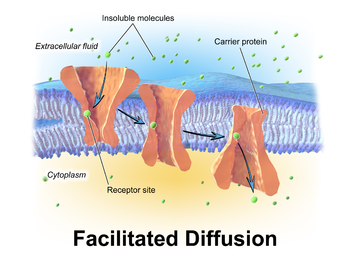
Facilitated Diffusion
Facilitated diffusion is a type of diffusion, which means it is passive transport across the cell membrane. Facilitated diffusion does not require energy from the cell to work.
The cell membrane is semi-permeable, which means some things can enter and leave the cell and some cannot.
In particular, polar molecules and charged particles cannot move through the cell membrane. Polar molecules are molecules in which one part of the molecule is positive and one part is negative. Water is a polar molecule.
Ions, or charged particles, also cannot move into the cell through the cell membrane without help.
Even though polar molecules and ions cannot move through the cell membrane, the cell still needs these in small concentrations. So, the cell has developed facilitated diffusion to get these materials into it.
The cell has channels built into the membrane that allow specific molecules and ions into the cell. You can think of these channels as guarded doorways and you need the password to be able to pass through the channel.
Polar molecules have an even more difficult time getting into the cell, especially water. The cell really does not want too much water in it; it has a special method for allowing water into the cell. Water must be escorted into the cell by a special protein known as aquaporin.
There are three types of passive transport: diffusion, osmosis, and facilitated diffusion. Because all of the methods utilized by facilitated diffusion are moving from an area of higher to an area of lower solute concentration, no energy is needed for any of these processes and it is considered passive transport.

Edited: 05 October 2022
Facilitated Diffusion
Facilitated diffusion is a type of diffusion, which means it is passive transport across the cell membrane. Facilitated diffusion does not require energy from the cell to work.
The cell membrane is semi-permeable, which means some things can enter and leave the cell and some cannot.
In particular, polar molecules and charged particles cannot move through the cell membrane. Polar molecules are molecules in which one part of the molecule is positive and one part is negative. Water is a polar molecule.
Ions, or charged particles, also cannot move into the cell through the cell membrane without help.
Even though polar molecules and ions cannot move through the cell membrane, the cell still needs these in small concentrations. So, the cell has developed facilitated diffusion to get these materials into it.
The cell has channels built into the membrane that allow specific molecules and ions into the cell. You can think of these channels as guarded doorways and you need the password to be able to pass through the channel.
Polar molecules have an even more difficult time getting into the cell, especially water. The cell really does not want too much water in it; it has a special method for allowing water into the cell. Water must be escorted into the cell by a special protein known as aquaporin.
There are three types of passive transport: diffusion, osmosis, and facilitated diffusion. Because all of the methods utilized by facilitated diffusion are moving from an area of higher to an area of lower solute concentration, no energy is needed for any of these processes and it is considered passive transport.

Edited: 05 October 2022
 Knowt
Knowt
